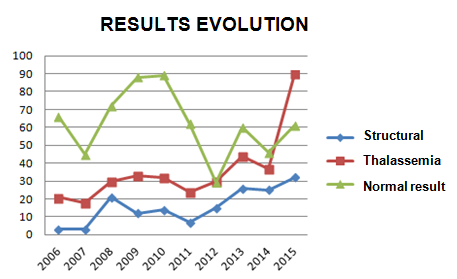
Contributions
Abstract: PB2155
Type: Publication Only
Background
The diagnosis of hemoglobinopathies (Hbpts) has changed in recent years due to immigration, with an increase in structural Hbpts. In our region, Asturias, population census is 1,061.756 habitants; 48,097 out of them are immigrants.
Aims
Review the incidence of structural Hbpts and thalassemias in our region in the last 10 years.
Methods
A retrospective analysis was performed with 1202 hemoglobin (Hb) studies at Hospital Universitario Central de Asturias between January 2006 and March 2016. The studies came from medical applications, the finding of abnormal Hb patterns in the HbA1c test or suggestive results of thalassemia on hematimetry test.
Results
We analyzed 1202 patients, 49% were males and the median age was 33 years (range 0-85).

Conclusion
Structural Hbpts are the main diagnosis in immigrants. The incidence is still small, although increasing in the last 3 years, so a neonatal screening program is being implemented.
Both HPLC and CE are simple, fast and efficient methods in the diagnosis of Hbpts.
Session topic: 25. Sickle cell disease
Keyword(s): Thalassemia, sickle cell disease
Abstract: PB2155
Type: Publication Only
Background
The diagnosis of hemoglobinopathies (Hbpts) has changed in recent years due to immigration, with an increase in structural Hbpts. In our region, Asturias, population census is 1,061.756 habitants; 48,097 out of them are immigrants.
Aims
Review the incidence of structural Hbpts and thalassemias in our region in the last 10 years.
Methods
A retrospective analysis was performed with 1202 hemoglobin (Hb) studies at Hospital Universitario Central de Asturias between January 2006 and March 2016. The studies came from medical applications, the finding of abnormal Hb patterns in the HbA1c test or suggestive results of thalassemia on hematimetry test.
Results
We analyzed 1202 patients, 49% were males and the median age was 33 years (range 0-85).

Conclusion
Structural Hbpts are the main diagnosis in immigrants. The incidence is still small, although increasing in the last 3 years, so a neonatal screening program is being implemented.
Both HPLC and CE are simple, fast and efficient methods in the diagnosis of Hbpts.
Session topic: 25. Sickle cell disease
Keyword(s): Thalassemia, sickle cell disease


